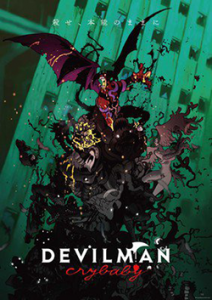
(Neo, Uncooked Media)
Thanks to his friend, Ryo, the sensitive, weepy Akira is merged with a demon in a blood-drenched orgy. Now he transforms into the berserk hero Devilman, created to save humanity. Or was he?
Now on Netflix, Devilman Crybaby is directed by Masaaki Yuasa, a great anime artist, who made terrific series like Tatami Galaxy and Ping Pong, and delightful cinema fare such as Lu and Night is Short. We interviewed Yuasa previously, where he seemed nervously thrilled about making Crybaby. He was, he said, a huge fan of the original.
That original, Devilman (minus the Crybaby tag), is a horror-action epic from 1972. Written by manga’s most terrible enfant, Go Nagai, it tells of a sensitive man, Akira, who’s led by his friend into a Satanic bloodbath orgy. This lets Akira transform, Superman style, into a demon hero with horns and hooves to fight more demons.
British readers are likelier to remember the gory video version (1987-90), which was released by Manga Entertainment and reached late-night Channel 4. Crybaby remakes several of the same tentpole set-pieces from the video, from a slaughter in a nightclub to a battle with a bird demon. But beyond that, Crybaby also evokes a host of still more lurid titles from the ‘80s and ‘90s, from when anime was marketed as “barely legal” video nasties.
Like them, Crybaby comes with demon monsters, splatter gore, and torrents of anime sex: bare boobs and butts, gaping pudenda, frantic copulation and the messes that come with it. In one scene, the hero drenches a ceiling in what we might call Devilman goo. In an orgy, a guy humping his playmate gets a surprise when her thighs grow Jaws teeth and bite him in half.
If you’re not used to such excesses in anime – and particularly if you’re a male reader born around, oh, 2002 – that may be all you need to watch Crybaby goggle-eyed. If, however, you’re old enough to recall Wicked City and Overfiend, you may think you’ve seen this twenty years ago, and why exactly does it deserve to come back as a high-profile Netflix series in 2018, an ambassador for today’s anime? For the age of Overfiend was the dark time when everyone in Britain seemed to think anime was “tits and tentacles” We fans might vainly evangelise about, say, Maison Ikkoku or Kiki’s Delivery Service; Nah, we were told, it’s all just porn. Thanks to Netflix, those happy days may be here again.
But surely Yuasa can lift Devilman Cybaby above that? Here’s the shocker; he doesn’t. There are no end of potent, powerful story opportunities in the Devilman story. It’s a great concept, dripping with anguish and tragedy and cruel cosmic irony. But time and again, Crybaby blows it. Devilman, or Akira as he’s called in human form, is boring. We don’t care about his foster family, including pretty sisterly love-interest Miki and her pious Christian parents. We don’t care about Akira’s bromance with Ryo, the childhood friend who leads our hero into demonhood in a first episode that is so cheesily, lackadaisically told that it must surely be meant as an arch parody – to what end, only Satan knows. No do we care about Akira’s male tears, or the girl maddened by being stuck in Miki’s social eclipse, or the Peak Anime lurching in the last episodes between sappy sentiment and mass murder.
Even Crybaby’s quirks are half-hearted. In early episodes, some tough guy characters launch into bouts of hip hop out of nowhere; then they stop doing that and it’s not mentioned again. (Maybe Yuasa loves Sion Shono’s live-action rap epic Tokyo Tribe; someone has to.) There’s also a laboured strand about track running – Akira, Miki and several other principal characters are athletes, so they can charge, scramble and claw (well, a bit) round the screen, like the characters in many past Yuasa anime. The difference is that in those anime it was gripping, thrilling to watch. Here it’s “meh”, shocking because it really shouldn’t be.
This goes for Crybaby’s presentation generally. Time and again, the viewer clocks the “artful” elements of a scene, the framing, the colours, and shrugs; it’s just Yuasa stuff and Devilman stuff, merged but inert, desperately needing a detonator. The music’s far better, especially when the story reaches a peak in the penultimate episode, but it’s carrying a script and visuals that aren’t worthy. The last episode goes unsurprisingly for grandeur, a war to end all anime wars. It hasn’t an iota of the impact of End of Evangelion, which it evokes over and again
Far more interesting are the poignant images which bookend the series, of Akira and Ryo as little boys on a slab of a cliff, each of them holding diametrically different views of life and death. Graphically and emotionally strong, the images are everything the show should have been. But what Crybaby is can’t hold a candle to mainstream anime horrors like Attack on Titan or Tokyo Ghoul; and as for artier, sexy horror, Belladonna blows Crybaby away all the way from 1973, only a year after Devilman was born.
